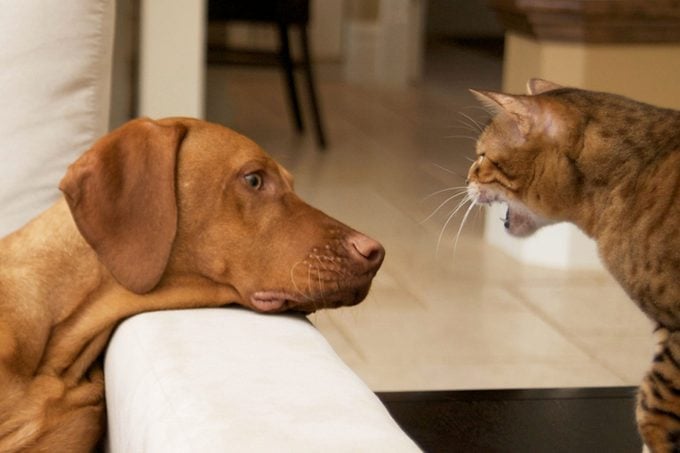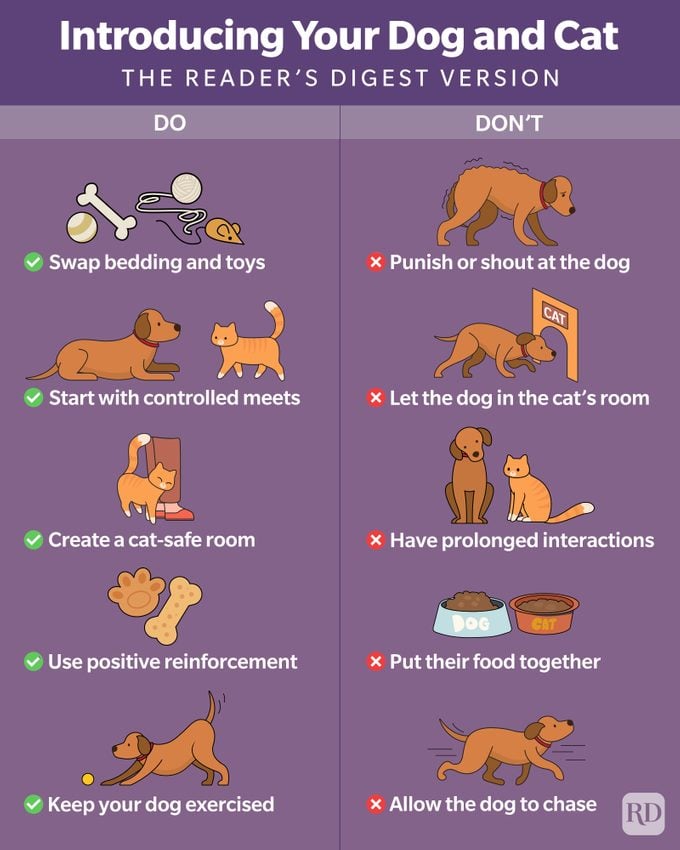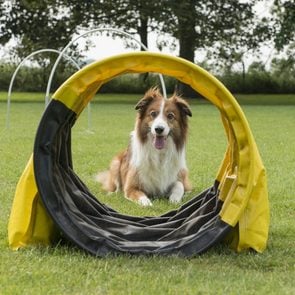Do Dogs Really Hate Cats? Here’s What the Experts Say
Updated: Jan. 12, 2024

They're often considered mortal enemies, but can canines and felines actually be friends? Here's what you should know.
They’re fighting like cats and dogs. How often have you heard that phrase to describe siblings or co-workers or frenemies who just don’t get along? It’s a tale as old as time, depicted in countless movies and cartoons: dogs chasing cats, cats hissing at dogs, the two fighting, well, like cats and dogs. But is it actually true? Why do dogs hate cats—or is it just a myth?
We talked to experts to get to the bottom of dog behavior and cat behavior, and learned that often, like most relationships, whether dogs and cats get along comes down to communication. We also learned how to train a dog if you want to introduce a new cat or kitten into your home. There are a lot of things your dog hates, but if you want to find out if dogs hate cats or if it’s all fake between these household frenemies, read on.
Get Reader’s Digest’s Read Up newsletter for pet insights, humor, cleaning, travel, tech and fun facts all week long.
Why do dogs hate cats?
The truth is, dogs don’t hate cats, but they are two different species and misunderstandings are bound to happen. “Dogs and cats aren’t destined to be foes,” says Sara Ochoa, DVM, veterinarian and co-founder of How To Pets. “Like humans, they can form profound, enduring connections or experience conflict based on several factors.” Here’s why they may not get along.
A dog’s prey drive
The root of the myth of why dogs hate cats may stem from dogs’ instinctual need to chase and capture moving objects, inherited from their wolf ancestors. “This [prey drive] served an essential role in the survival of wolves and early dogs by ensuring they could secure food for themselves and their pack,” says Dr. Ochoa. Although domesticated dogs no longer need to hunt for their food, a cat’s quick movements can trigger this deeply ingrained instinct, making them think the cat is something that needs to be chased.
Different communication styles
While dogs bark, wag their tails and offer lots of dog kisses to express themselves, cat body language differs. Cats often communicate their feelings more subtly, which can cause misunderstandings on both sides. “For instance, a cat swishing its tail could signal irritation or a desire to be left alone, but a dog might interpret it as an invitation to play,” Dr. Ochoa says.
Different needs
Communication styles aren’t the only difference between cats and dogs. Personality differences can also come into play. Out of the two species, dogs are often the more outgoing, which is a nice way of saying they have no personal boundaries. Cats, on the other hand, value personal space and boundaries more. These differences in needs can sometimes lead to conflicts. “For example, a dog’s enthusiastic attempt to play might overwhelm a cat, leading to the cat feeling threatened or stressed,” says Dr. Ochoa.
Do cats hate dogs?

People often ask why do dogs hate cats, but what about the reverse? Do cats hate dogs? “No, cats do not inherently hate dogs,” says Karis Nafte, a certified dog behavior consultant and founder and owner of pet custody course Who Keeps the Dog. “Cats are both hunters and prey animals themselves,” says Nafte. “This means in any new situation or environment they find themselves in, they are always looking for potential danger to themselves as well as anything small enough for them to hunt.” Until cats are used to a dog, even a very playful one can seem like a threat.
Can dogs and cats learn to get along?
Believe it or not, not only are dogs and cats not destined to be mortal enemies, but nearly any dog and cat can learn to get along, as long as the owners are very patient and willing to go at the pace of their animals, says Nafte. Of course, there are certain affectionate dog breeds and adaptable personalities, such as golden retrievers, Labrador retrievers and poodles, that are considered cat-friendly dogs. But “the degree to which a dog and cat are [likely] to be friends is less about the breed [and more about] the individual temperament and socializing of each dog,” says Nafte. To help your dog socialize with cats, follow this plan.
1. Start slow
When introducing a new dog to a neighborhood cat or friend’s cat (or vice versa), do it gradually. Start with controlled meetings where both animals are on a leash. That way they can “observe each other without direct physical contact, reducing the risk of sudden reactions,” says Dr. Ochoa.
2. Don’t shout if your dog tries to chase the cat
Your instinct may be to yell “No!” when your dog thinks it’s time to play chase, but that can be more detrimental than beneficial. “When you shout, it sounds like you are barking along with your dog and you will also scare your cat in the process,” says Nafte. “Punishing your dog simply creates more stress and confusion.”
3. Use positive reinforcement
Reward your cat and dog with the best treats, affection and praise when they are near each other and exhibiting calm behavior. Dr. Ochoa says this helps them associate positive experiences with being in each other’s presence.
4. Keep your dog well-exercised
“Any dog that is bored or frustrated at home is much more likely to overreact to stimulus like cats,” says Nafte. But a tired dog that’s had good daily exercise is much less threatening (and less enthusiastic) to a cat. Also, make sure you provide lots of appropriate chew toys to keep them entertained and give them other things to focus on besides the cat.

How should I introduce my dog to a new cat?
You’ve found the perfect feline addition to your family, but will Fido welcome him into the home? Here’s how to help both animals learn to love—instead of loathe—each other.
1. Swap bedding
Before you introduce the two animals in person, first do a scent exchange by swapping bedding or toys between the two animals. “This helps them become familiar with each other’s scent before they physically meet,” says Dr. Ochoa.
2. Create a cat-safe room
Before you bring your cat home, make sure you have a space that the dog cannot access where the cat has everything they need: litter box, food and toys. “This room should have plenty of hiding places the cat can go to until they feel safe and ready to explore,” says Nafte. After a few days, when the cat seems comfortable in its new environment and you are close to supervise, open the door and place a baby gate on the door so the cat can see out of the room but the dog cannot get into the room, allowing the cat and dog to smell each other in person.
3. Keep your dog entertained
While you have the door to the cat room open (and baby gate closed) feed your dog near the door or give your dog a healthy chew item or puzzle toy so the dog has something more interesting to do than look at or stare at the cat. “Ideally, you want the cat to see the dog calmly chewing on something rather than looking at or staring at the cat,” says Nafte. Repeat this a few times a day for a few minutes.
4. Start to leave the door open
After a few days of the above routine, if your dog has not exhibited any aggression toward the cat, start to leave the door open so your cat can wander into the house. It’s important to keep your dog on a leash during this step to prevent them from chasing or spooking the cat, says Nafte. “Keep treats in your pocket, and if the dog looks at the cat, then looks back at you, reward them with a treat for staying calm,” she says.
5. Get professional help, if needed
If you feel your dog is acting dangerously or aggressively toward your cat, is showing signs it needs obedience training or seems to be staring, stalking or freezing when they see the cat, then seek out a qualified, professional animal trainer to help you.
About the experts
- Sara Ochoa, DVM, is a veterinarian who currently works at the Animal Hospital of West Monroe in Louisiana. She is the co-founder of How To Pets, a website dedicated to vet-approved content about pets.
- Karis Nafte, CDBC, is a certified dog behavior consultant and pet custody mediator whose company, Who Keeps the Dog, works online with clients around the world. She has been helping owners integrate dogs and cats (and fix other behavioral issues) for the past 25 years.





















